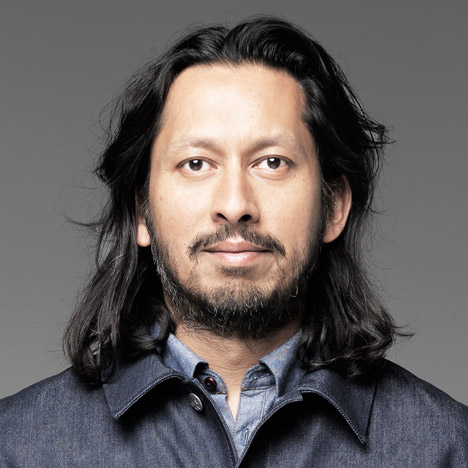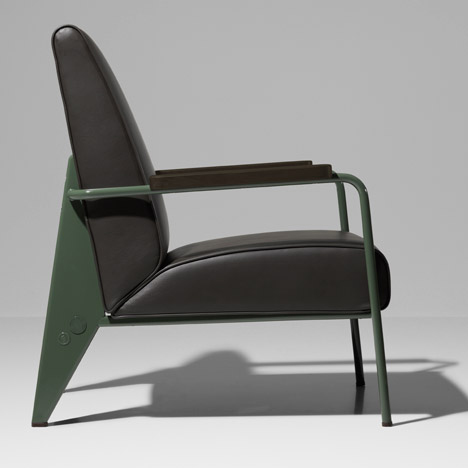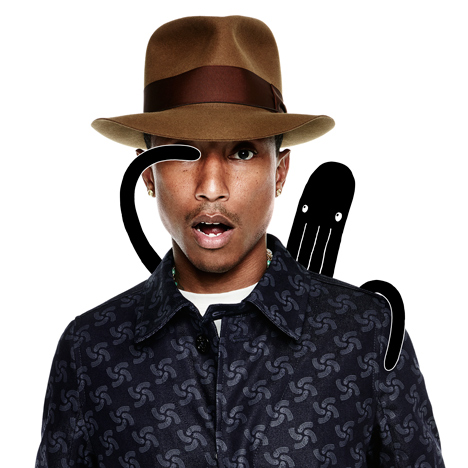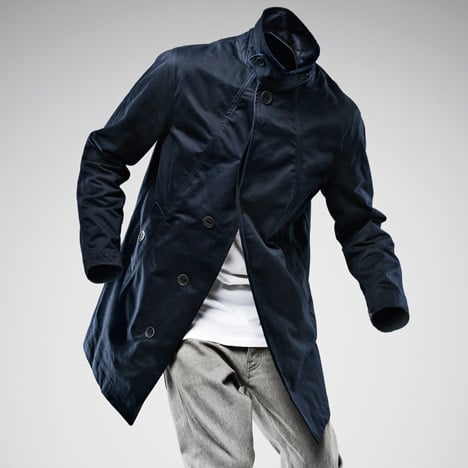Design "doesn't know how to democratise itself" says Shubhankar Ray
Design Indaba 2015: design brands operate in an "insider world" and are failing to connect with young consumers, according to the creative director of denim brand G-Star RAW (+ interview).
Talking to Dezeen after speaking at the Design Indaba conference in Cape Town last month, Shubhankar Ray said that elite furniture and lighting companies were failing to make their products accessible to wider audiences.

"I think that's the thing about the design world: it doesn't know very well how to democratise itself," he said. "It’s for the lucky few: people who know about the world of Vitra and Eames and Prouvé."
Ray, who was creative director for shoe brand Camper from 2000 to 2006 before joining Dutch clothing company G-Star RAW, collaborated with Vitra in 2013 to produce Prouvé RAW, a customised collection of furniture designs by pioneering French Modernist Jean Prouvé.

"There is a real Modernist heritage there and younger jeans consumers who know nothing about Prouvé suddenly got exposed to the idea of Prouvé," said Ray, who is now preparing to launch a second collection of office furniture based on Prouvé's designs. The Prouvé Raw: Office Edition will launch in Milan during the Salone del Mobile next month.
Ray argued that both Camper and G-Star Raw are closer to industrial design companies than fashion brands, since shoes and jeans are industrial products.
"Both Camper and G-Star fundamentally do not believe in fashion," he said. "So that means they don't believe in the obsolescence of fashion. That means they are closer to furniture designers because somebody makes a piece of furniture not for six months, but to last for a long time."

But most furniture and lighting brands fail to reach out beyond their existing consumer bases in the way that clothing companies do, he said. 'There is a great opportunity to make design brands much more energised because their vibrational energy is today only on one level, in one particular audience," he said. "So it never gets out of there."
Ray also spoke about the importance of celebrities to brands, saying: "Today, celebrities are the biggest selling devices in the world, because they popularise everything from brands to behaviours to new ideas."

However Ray has tried to use celebrities in more meaningful ways at G-Star Raw, getting actor Dennis Hopper to read poetry by Rudyard Kipling at a fashion show in 2008 and more recently collaborating with Pharrell Williams on the Raw for the Oceans project, which turns plastic salvaged from the sea into clothing.
"If you think about celebrities as currency, then every other currency is going to devalue and actually celebrity appears to be, over the last five years, resisting devaluation because of the internet and technology," he said. "It keeps it going."
Here's an edited transcript of the interview with Ray:
Marcus Fairs: Tell me about your background.
Shubhankar Ray: I was born in India, in Calcutta. I arrived in England as a young kid. I grew up in a way where I was always playing with contradiction because outside my house was England and inside my house was India. And this is true of all immigrants. This created, like F. Scott Fitzgerald said, a sense that intelligence is the ability to carry around two contradictory ideas in your head at the same time.
Marcus Fairs: You were creative director of Camper in Mallorca from 2000 to 2006. How did that contradictory condition feed into your work for them?
Shubhankar Ray: I thought I was the opposite of Camper, you know. I had come from London; I had been working in New York and Tokyo and LA. Camper were rural farmers. The word Camper even means “farmer” in Catalan. I went to live in the countryside in Mallorca and this was like such a reversal of the life I had been living.
It allowed me to feed certain things from my world into their rural world. It became this brand that was on the one hand traditional, old, rural, slow; everything that the modern world is the opposite of. It was the opposite of Nike: if Nike said "air" we said "earth". If Nike said "run" we said "walk". And from this we made the positioning, advertising campaign, the design of the shops and how the brand would manifest itself.
Marcus Fairs: What was the impact of your work on Camper?
Shubhankar Ray: I was able to make them into a globally relevant player – operating with a very distinct identity, very highly differentiated, different to everybody else and almost a mixture of analogue and digital at a time where the whole world was going digital. Analogue was being replaced.
They increased their turnover significantly. They were able to go from having shops mainly in Spain to having shops in every major capital city in the world. And I think I helped them to translate their DNA and give it a visualisation where people who were not from their rural reality could connect with it in New York, in Berlin, in San Francisco, in Tokyo and London.
Marcus Fairs: And then you left Camper and went to G-Star RAW. What have you been doing there?
Shubhankar Ray: They wanted to become global and move from being a European challenger to a global player in the denim business. They had been mainly selling to retail customers, so there was no advertising. So I was mainly working on shifting them in a industry that is retro and nostalgic to a Modernistic positioning, taking influences from industrial design and not the world to fashion.
Marcus Fairs: Marc Newson has designed clothing for G-Star RAW. Were you involved in getting him on board?
Shubhankar Ray: He had already been working for G-Star and then he took a break. I hadn't seen Marc for ten years, and then I met him randomly with the owner and we decided to start again. And Mark was somebody who we admired and he was a good input to put into your brand because he makes you think differently. Again, it's the plus and minus of opposite views. He had never done clothing so it was a good, interesting thing for both of us.
Marcus Fairs: You collaborated with Pharrell Williams for the Raw for the Oceans project. Tell us about that.
Shubhankar Ray: Today, celebrities are the biggest selling devices in the world, because they popularise everything from brands to behaviours to new ideas. And if you think about celebrities as currency, then every other currency is going to devalue and actually celebrity appears to be, over the last five years, resisting devaluation because of the internet and technology. It keeps it going.
So normally what happens is that when a celebrity is in an ad, the audience knows that the celebrity has been bought. So they don't believe in it. You've just spent $5-10 million on something that's beautifully produced and everybody looks great, but the audience smells it as bullshit.
But another way to go might be to use a celebrity as a catalyst; not always show them in the campaign, not always use the easiest mechanism. And then be able to use the celebrity as an accelerator for the ideas, so they become also the champion of the idea.
So the way we have been working with Pharrell Williams is to not put him in the campaigns. He is not the poster boy for our RAW for the Oceans project. Instead we use him as an inextricable part of the acceleration of that idea. So we have put him in in his role of creative director of [recycled yarn brand] Bionic, involved in our product design process because the man has very good taste and likes clothing. He is very much involved, but we don't put him in the ads.
So it becomes much more believable for the audience because Pharrell is really interested in the ocean, he grew up by the ocean. He is a business partner in our project so that means if the product sells and does well, he gets some of the profit. It is a very different type of relationship and I think you want to find different ways to collaborate with celebrity because they themselves are also brands, so they also want to do something creative and innovative. When you have good ideas, these have traction also for the celebrity because it's good for them. You don’t just pay them five million to put them in the ads.
Marcus Fairs: Camper and G-Star RAW seem closer to industrial design brands than fashion brands. Would you agree with that?
Shubhankar Ray: Both Camper and G-Star fundamentally do not believe in fashion. So that means they don't believe in the obsolescence of fashion. That means they are closer to furniture designers because somebody makes a piece of furniture not for six months, but to last for a long time.
Street culture, where many of these brands operate, has a heritage and is very resourceful. It recycles stuff and re-appropriates stuff. So it's a very creative world. In that world, there are only two items or products that have a cultural value: jeans and sneakers. They cut through culture. They cut through everything in terms of age, race, taste, sexuality, young, old, and they have this cultural heritage.
If you look back in the history of denim and sneakers, they were originally made by technicians. So the designer was involved. Therefore they are driven primarily by functionally and durability and secondly by form. Today form becomes very important to dramatise that functionally, but it is secondary. So I think that is the key difference.
Marcus Fairs: Hella Jongerius was talking the other day about how some design companies have kind of lost their way, and have been taken over by marketing. You could argue that they are trying to do what fashion brands do very well. But what would you do with a furniture or lighting brand? Their marketing tends to be pretty unsophisticated.
Shubhankar Ray: Yeah, I'd make them more interesting and make them have an electric charge with their audience. I had this experience with Vitra, when we collaborated with Vitra to redesign Jean Prouvé's furniture. It was brand-DNA crossover. And what was interesting was that you could democratise high design, which was for the lucky few.
Marcus Fairs: Is design too elitist?
Shubhankar Ray: I think that's the thing about the design world: it doesn't know very well how to democratise itself. But the design world could be quite open to that level of democratisation because it would get more people into what is a good thing.
But what I see in that world is that it is an insider world. It's for the lucky few: people who know about the world of Vitra and Eames and Prouvé. It's all good, but it's an insider world. It doesn't get outside.
Design can learn from the fashion business because the fashion business did get outside. It used to be for rich French ladies who would go to a couture show that was very private, and today on the street you can buy a pair of jeans that are 20 dollars, right up to 2,000 dollars. And jeans are interesting because they are a democratic item and much of design – the output – is a democratic item; a chair, a kitchen utensil.
And in a way I think that there is a great opportunity to make design brands much more energised because their vibrational energy is today only on one level, in one particular audience. So it never gets out of there. I would love to do something with a design brand because the challenge is: can you get other vibrational energies working? That can engage a lot more people.
So going back to the Vitra collaboration, what was interesting was that there was an interesting swap of audiences. There is a real Modernist heritage there and younger jeans consumers who know nothing about Prouvé suddenly got exposed to the idea of Prouvé.
Similarly our work with Marc Newson: how do you democratise one of the most important industrial designers of the 21st century? Who sells a chaise longue to a collector for 1.2 million? How do you democratise this? How do you put this in the street and give access to a young kid?
Marcus Fairs: And are these young consumers interested in Marc Newson and Jean Prouvé?
Shubhankar Ray: Well they will buy their sweatshirts, provided you can give them a sweatshirt for less than a couple of hundred euros.
Marcus Fairs: You're about to launch a collection of Jean Prouvé office furniture with Vitra. How did that come about?
Shubhankar Ray: We launch the collection at Salone del Mobile in Milan next month. We wanted the furniture for our own offices, so that is how it started. We’d already done a Prouvé home-furniture collaboration with Vitra. We just moved in a year ago to our new building, G-Star HQ, which was designed by Rem Koolhaas and inside we needed furniture for ourselves. We primarily went into the Prouvé stuff because we were fans. So we developed an office system out of the Prouvé office furniture but tuning it a bit for our spec and for that building.
We ergonomically changed it so that it is set up for 21st-century modern interiors – we're all a bit taller, so we had to extend things and make it for modern human beings rather than the size of people in the 1940s. It's made by Vitra so the spec is great. We will retail it for $2,000 or €2,000. So suddenly it makes the world of Prouvé more accessible.
Marcus Fairs: And Prouvé wanted design to be democratic at the time didn't he? But technology didn't allow it to be cheap enough.
Shubhankar Ray: Yes he wanted his design to be democratic so it's quite on point and quite honest. You're not veering too far away from Prouvé's original ideation.